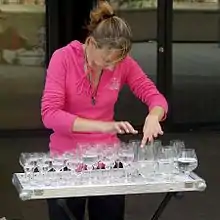glass harp
English
WOTD – 22 November 2016

A street performer playing a glass harp in Cologne, Germany
Etymology
Possibly a calque of German Glasharfe, from Glas (“glass”) + Harfe (“harp”) (see the 1969 quotation).
Pronunciation
- (Received Pronunciation) IPA(key): /ɡlɑːs hɑːp/
Audio (RP) (file) - (General American) IPA(key): /ɡlæs hɑɹp/
Audio (AU) (file)
Noun
glass harp (plural glass harps)
- A musical instrument consisting of glasses (typically wine glasses) tuned by putting different amounts of liquid into them. Sound is produced by rubbing one's fingers around the rims of the glasses, causing them to vibrate.
- 1969, “Glass harmonica”, in Willi Apel, editor, Harvard Dictionary of Music, 2nd rev. and enl. edition, Cambridge, Mass.: The Belknap Press of Harvard University Press, →ISBN, page 347:
- A newer glass instrument is the glass harp [G[erman] Glasharfe] constructed by B[runo] Hoffmann in 1929. Similar to the musical glasses of England, it consists of 46 individually tuned glasses fixed on a resonant table.
- 2000, Thomas D. Rossing, “Glass Musical Instruments”, in Science of Percussion Instruments (Series in Popular Science; 3), Singapore: World Scientific, →ISBN, page 182:
- Glass harmonicas are basically of two types. One type employs vertical wine glasses arranged so that the performer can rub more than one glass at a time. A collection of glasses played in this manner is sometimes called a glass harp. The other type, called the armonica by its inventor Benjamin Franklin, employs glass bowls or cups turned by a horizontal axle, so the performer need only touch the rims of the bowls as they rotate to set them into vibration […].
- 2007, C. Barry Carter, M. Grant Norton, “Processing Glass and Glass-ceramics”, in Ceramic Materials: Science and Engineering, Springer, →ISBN, pages 476–477:
- The glass harp produces the "sound of the universe" according to [Johann Wolfgang von] Goethe. The musician [Christoph Willibald] Gluck gave an entire concert using the glass harp in London in 1746. Sound is made when a wine glass "sings": run your finger around the rim. The sound is thus produced by making the glass vibrate rather than by making the air in the container vibrate (like blowing over a bottle).
- 2012, Katherine Monk, “Facing Down the Grim Reaper: Illness and Survival”, in Joni: The Creative Odyssey of Joni Mitchell, Vancouver, B.C.: Greystone Books, D&M Publishers, →ISBN, page 42:
- Joni [Mitchell] and Neil [Young] have both used alien and spaceman imagery to articulate their feelings, in interviews as well as in their lyrics. Listen to the words for Young's "After the Gold Rush" (1970) and you will hear a whole story of humanity's next exodus into space, a tale that prompted Linda Ronstadt, who covered the tune with glass harps, to say: "I would think, 'This is the future. Neil's humans leave the planet and go off to start a new space colony.' I've always felt Neil had a great deal of really uncanny prescience in his writing."
Synonyms
Hypernyms
Related terms
Translations
Translations
|
See also
This article is issued from Wiktionary. The text is licensed under Creative Commons - Attribution - Sharealike. Additional terms may apply for the media files.